Farewell visit to James David’s Austin garden, part 2
A grand limestone staircase bisected by a rill leads from the back of the house to a large pond in the lower garden.
Yesterday I showed you around the upper level of James David’s magnificent garden, which I visited in late March and which is currently for sale as the owners prepare to relocate to Santa Fe. Today let’s take the paths that lead down into the ravine behind the house and back up to the detached studio.
Behind the house a large cistern collects rainwater from the roof and seems to spill surplus water into a stone trough. In actuality, I think this must be an illusion because otherwise the water would soon run dry — even though our current rainy spring might suggest otherwise. I’d guess the rainwater is actually stored for use on Gary’s vegetable garden, visible in the background. This running faucet must be plumbed via a hidden pipe, creating the illusion that the cistern is the source of a long water passage through the back garden.
The water reappears a few steps below, spilling from a hidden stone channel into a small, stone-edged pool.
A wider view shows glossy holly ferns (Cyrtomium falcatum) doing a good air plant impression by sprouting from gaps in the wall.
A collection of fossils and pretty stones adorns a corner of the wall.
From the pool, water flows below ground into a simple metal pipe, which spills into a stone trough that’s been repaired with board-formed concrete. A second, smaller trough accepts an overflow stream. These troughs, with their musical splashing, sit next to the dining patio shown yesterday.
Underground the water goes again, and then it reappears at the top of the most dramatic feature of the garden: a grand limestone staircase bisected by a rill that runs a trickle of water all the way to the rectangular pond at the bottom of the stair. Behind the pond, an off-center stone stair leads up to a lap pool. Another path leads to a large greenhouse.
Here’s the view from behind the pond, looking back at the grand staircase and the house. ‘Will Fleming’ yaupon hollies once lined each side of the stair, creating a vertical screen, but these days it’s edged with boxwood.
Detouring to the right, let’s follow a path that leads up the side of the garden, past a low retaining wall beautifully made of various materials, including urbanite (broken concrete) on top.
Variegated agaves behind the wall
And a chicken coop!
Turning around, let’s head back down to the lower garden. Ahead is the large pond, and beyond that are pollarded Mexican sycamores.
Hardscape in this garden is masterfully crafted and enticing. You want to explore every curving stair, cross every bridge, investigate every long path framed by arbors and shrubs. But there’s also an element of danger to many of the walks, which universally lack handrails. They imply, you will be mindful of where you put your feet. I find it delightfully adventurous. But you definitely don’t want to get so distracted by the plants or the views that you fall backwards off a wall.
Now we’ve found the swimming pool, which sits well above the pond. Flowering shrubs and trees screen one side…
…while the other is open and offers a lovely view of the pond garden.
I was smitten by this flowering tree at the end of the pool: jack tree (Sinojackia xylocarpa), which James said he got from Forestfarm online nursery. They don’t seem to have it in stock now, but I see that it’s also grown by Texas grower Greenleaf.
The flowers dangle like white parachutes, reminiscent of those on white potato vine.
Stone stairs by the greenhouse are used to display potted agaves and other succulents.
Beautiful, but mind your ankles.
They are such camera hogs. They know they look good from every angle.
Potted cacti line a long limestone shelf along the front of the greenhouse.
A few tropicals, like this clivia, add colorful flowers to the mix.
Looking back toward the house you see the grand staircase and, closer, a wooden bridge that crosses a dry stream and wet-weather garden. The Mexican sycamores (Platanus mexicana) are planted in a grid, their pollarded canopies creating an umbrella effect.
Crossing the bridge, which is lined on one side with more potted plants, you get another view of the sycamores and their white and green mottled trunks.
A stone stair by the greenhouse descends to the dry creek.
I’m sure the dry creek has seen a lot of action this spring.
On the left, another view of the pond
Pulling back a little, you can appreciate the lushness of the garden, with purple flowers of Texas mountain laurel (Sophora secundiflora) in the foreground. Now imagine that we’ve crossed the wooden bridge again, walked behind the greenhouse, and followed a decomposed-granite path that leads to the right…
…and to the newest section of the garden: a semi-wild meadow garden behind the award-winning concrete studio. A ruler-straight path leads the eye and foot between stone pedestals topped with cornucopia-like urns, across a metal bridge, and up some steps to a concrete wall that supports a contemporary pond (shown below). Notice the concrete balcony jutting out from the topmost window? I’ll share a picture from that vantage point in a moment.
A topiaried oak. James told me he’s not afraid to try topiary on any kind of plant.
Looking back, I find this view through the columns very romantic.
I liked this grassy, white-flowered plant, whose fleshy leaves reminded me of bulbine, but I can’t remember the name. Update: It’s St. Bernard’s lily (Anthericum liliago). Thanks, Diana, for the ID! Update 4/16: It’s actually Asphodelus fistulosus (see discussion in comments, below).
Asphodelus fistulosus, or onionweed
Native red buckeye (Aesculus pavia) was blooming too.
As you climb the stairs up to the studio, you come to an asymmetrical, concrete-edged pond. Here’s an overhead view from the studio balcony. What looks like a metal bridge from this angle…
…is actually a gabion wall that supports a metal pipe spilling water into the pond. A dry garden planted with Argentine saguaro and other xeric plants offers a contrast between wet and dry.
Koi live in the pond and came running swimming when Gary pulled out the fish food.
The view across the gabion wall and pond to the cornucopia urns and meadow garden
To the left of the pond, the dry garden continues, with Yucca rostrata and a pruned-up Chinese photinia (Photinia serrulata), if I recall correctly. James is a big fan of this photinia, though not of the overused red-tip variety.
More steps lead up to the studio. This is the view from the walk connecting studio and house.
The studio
A porch at the studio door holds a trio of potted plants. I like the circle motif of the tabletops and rear pot.
Ice plant in vivid bloom
James and Gary’s dog Alice made herself comfortable on the porch’s wooden bench.
I somehow neglected to take a photo of James while he was showing me around. But I’m grateful to him and to Gary for inviting me into their beautiful home and garden again. Visiting their garden has always been the highlight of the Open Days tour, and I’ll miss it. But who knows — maybe it’ll be on tour again one day with new owners at the helm. I hope so, and I’m sure James and Gary do too. Until then, I wish them bon voyage and happy garden-making in their new home.
For a look back at part 1 of my garden visit, click here.
All material © 2006-2015 by Pam Penick for Digging. Unauthorized reproduction prohibited.


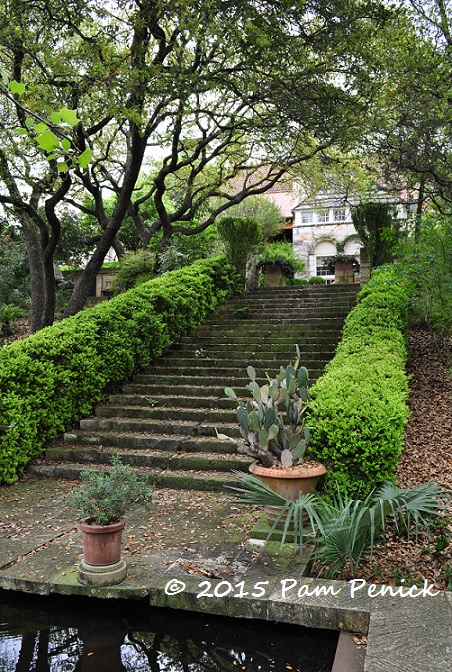
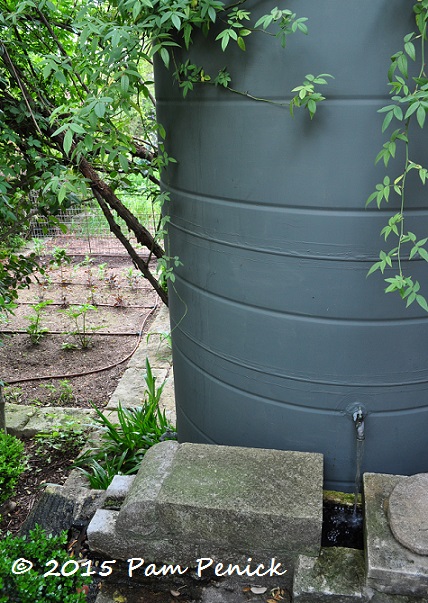
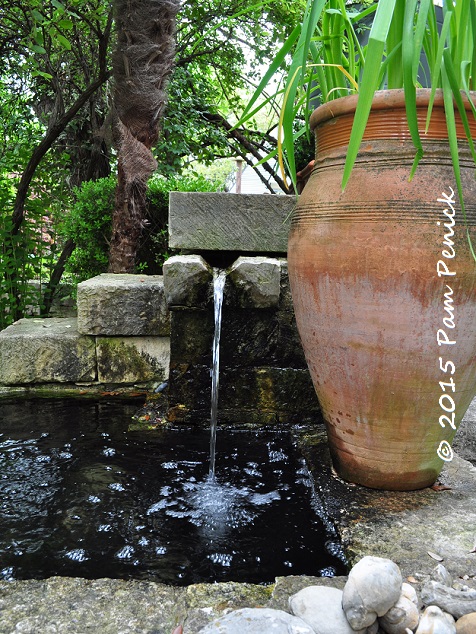
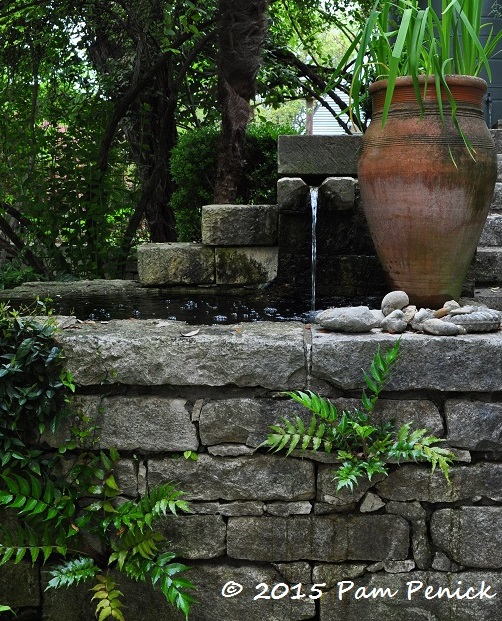
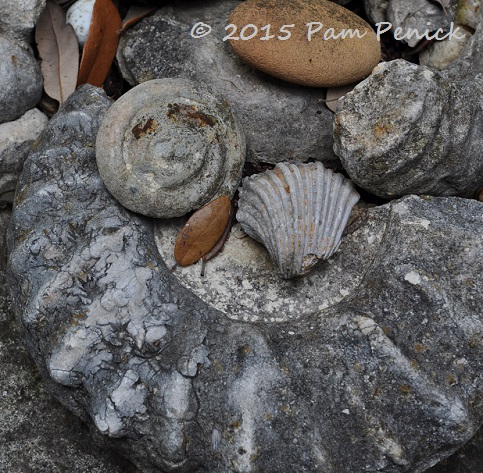
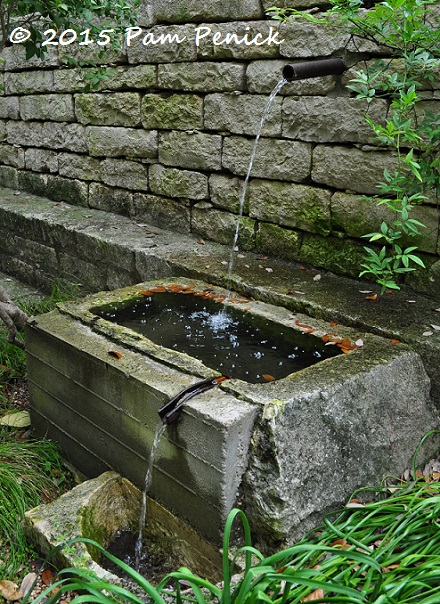
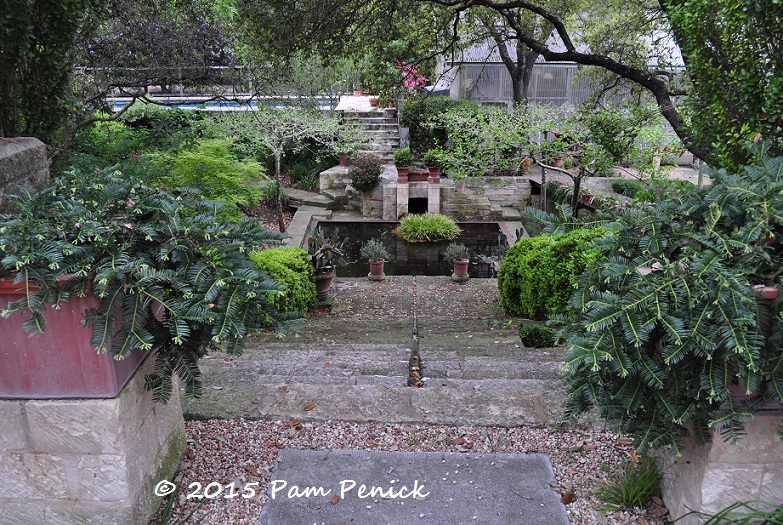
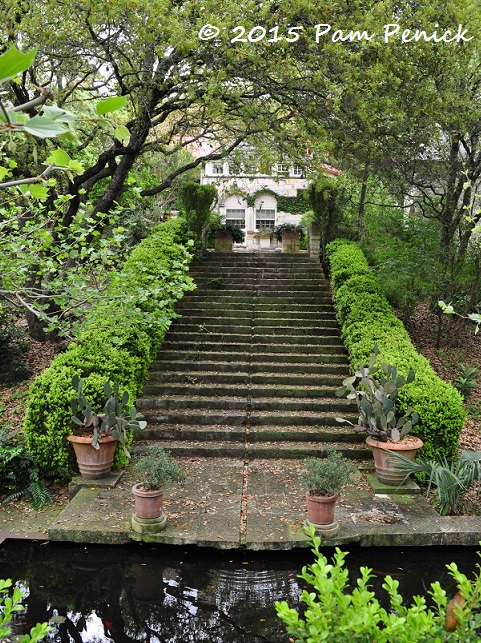
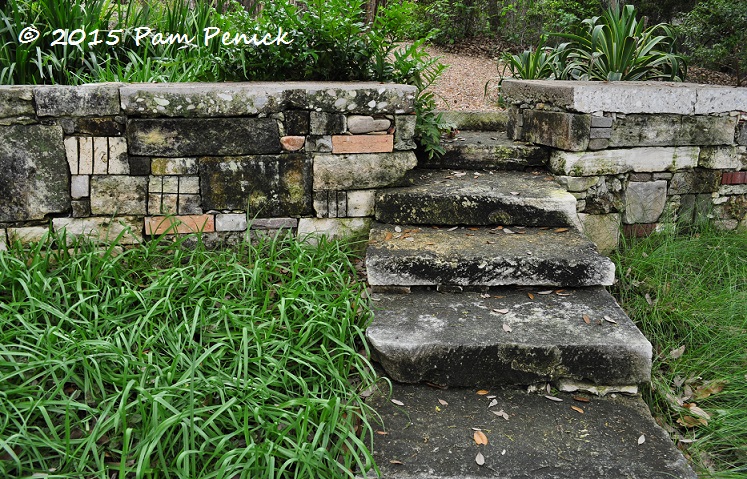
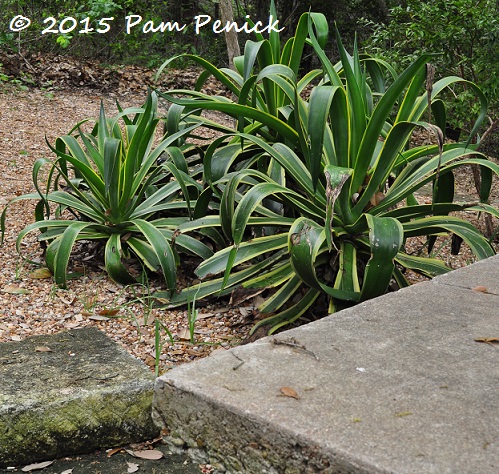
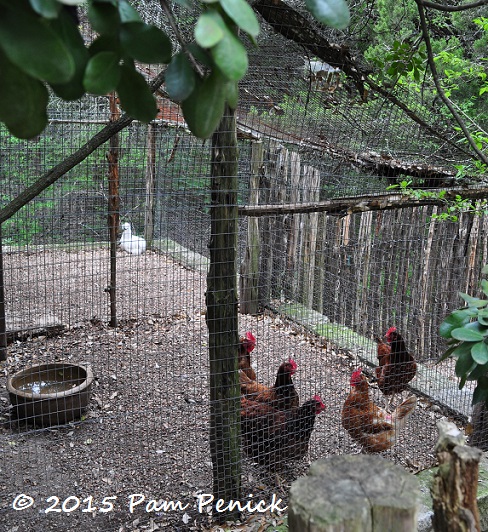
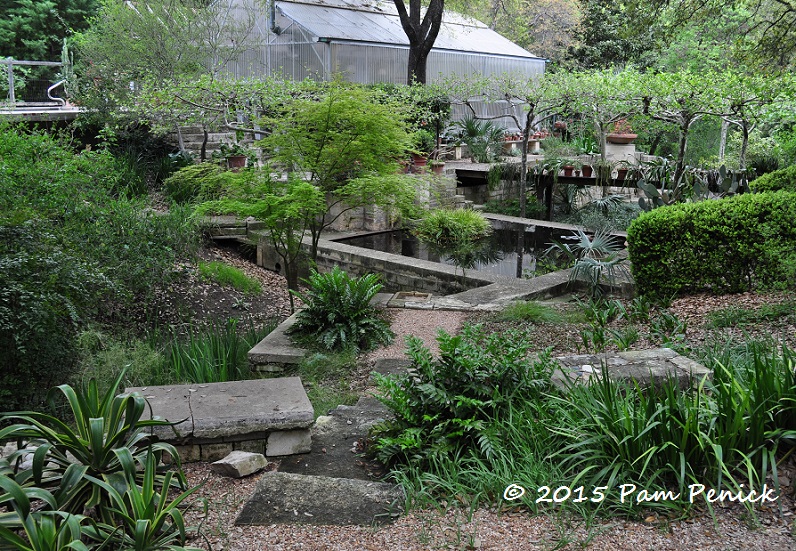
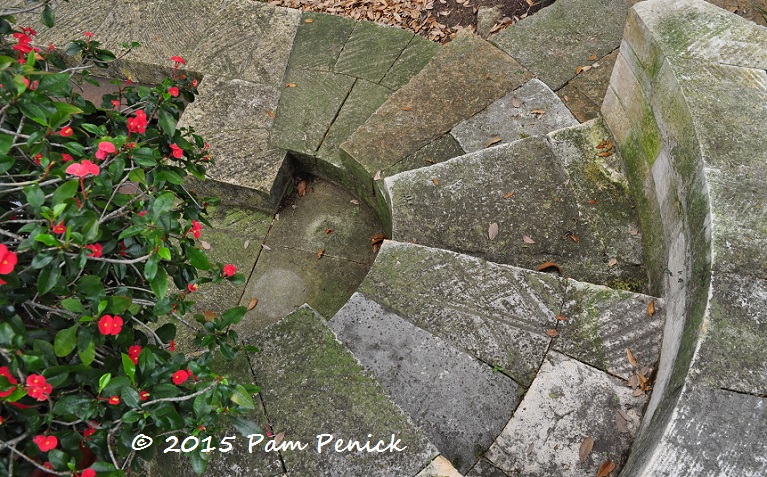
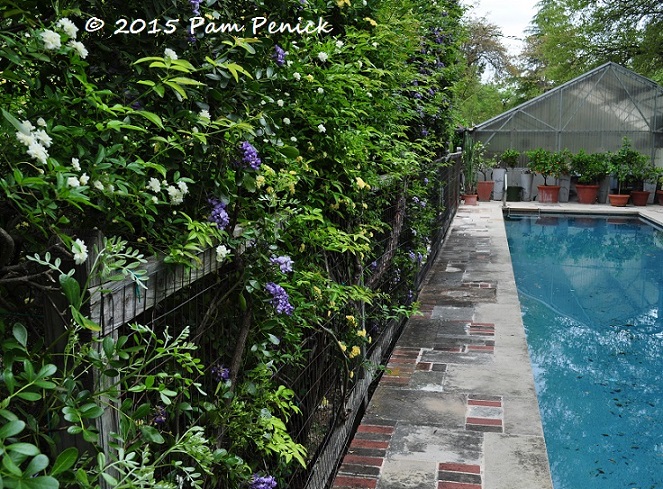
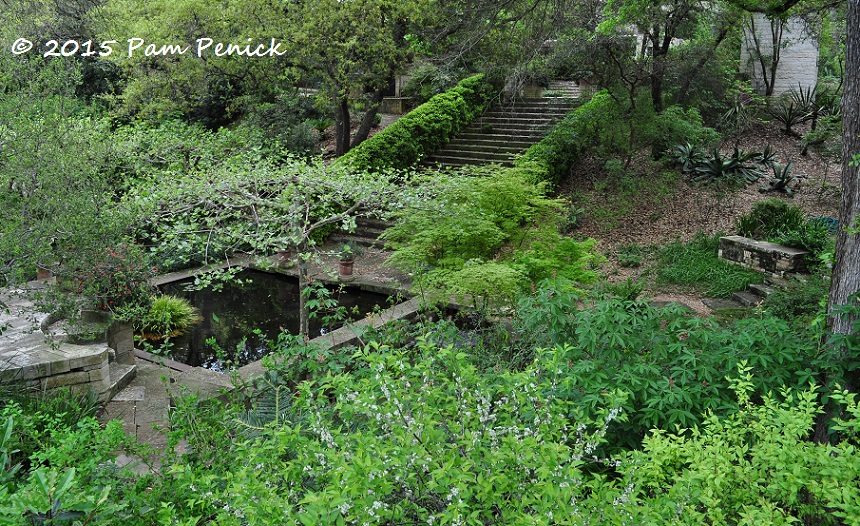
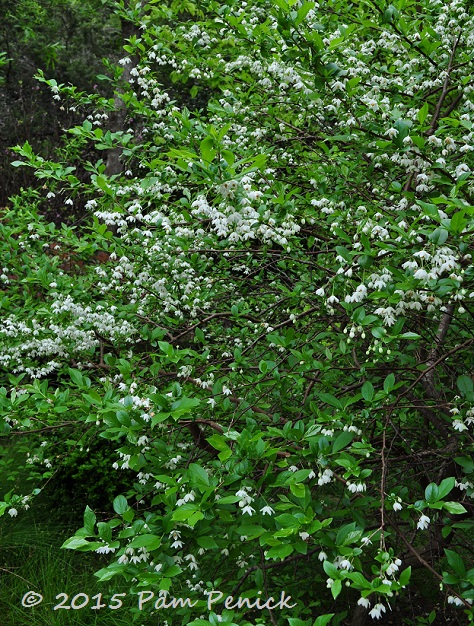
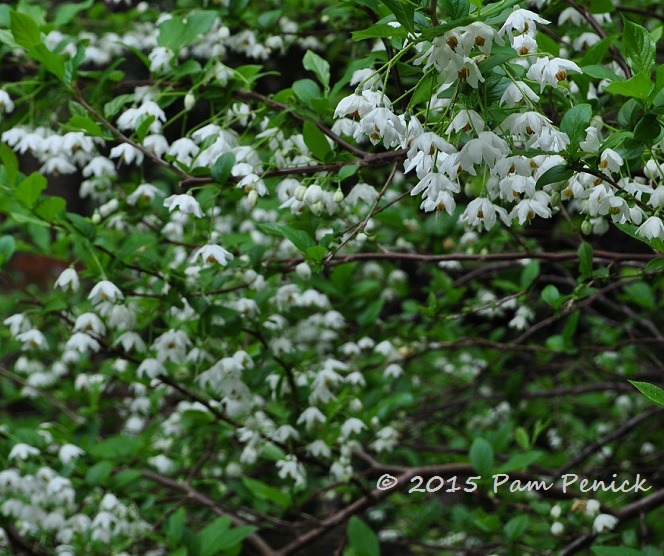
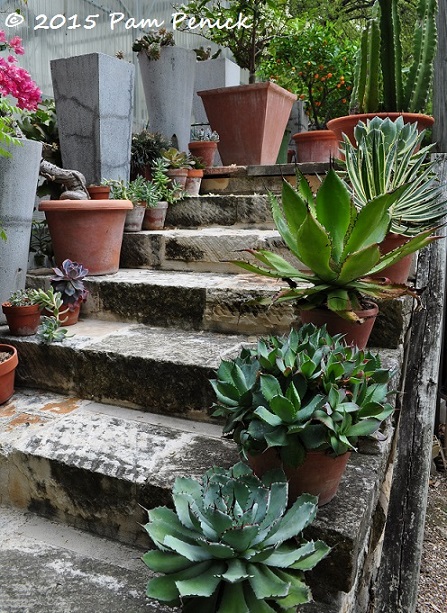
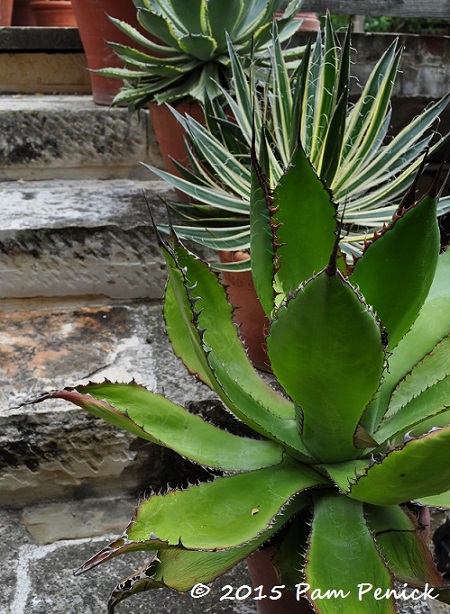
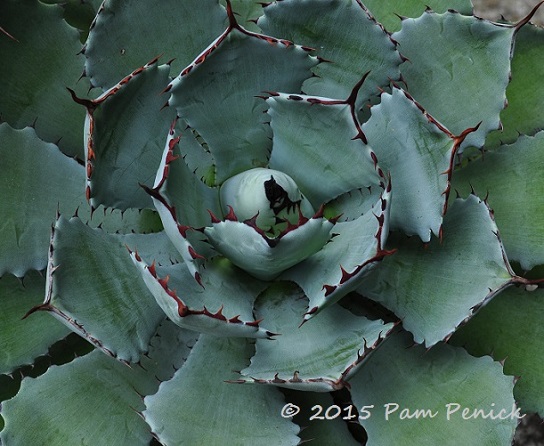
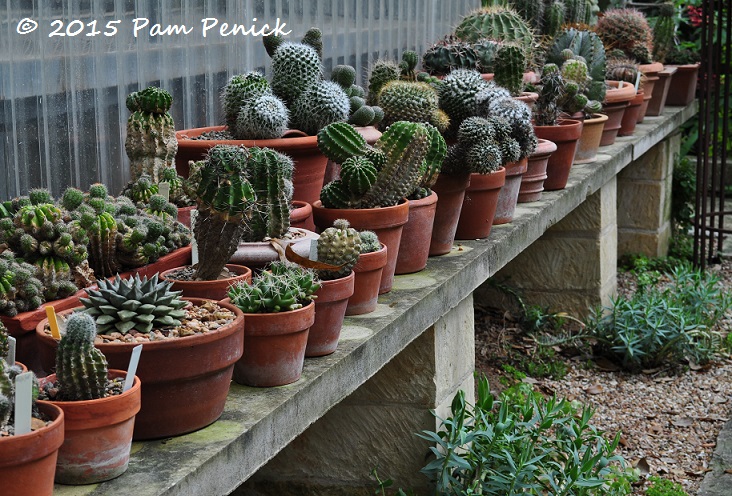
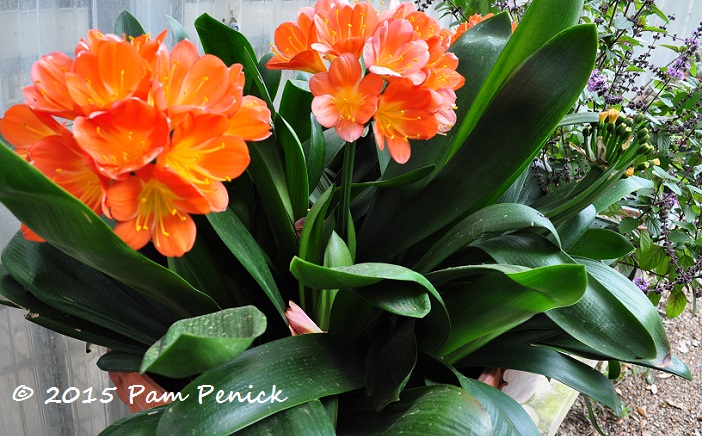
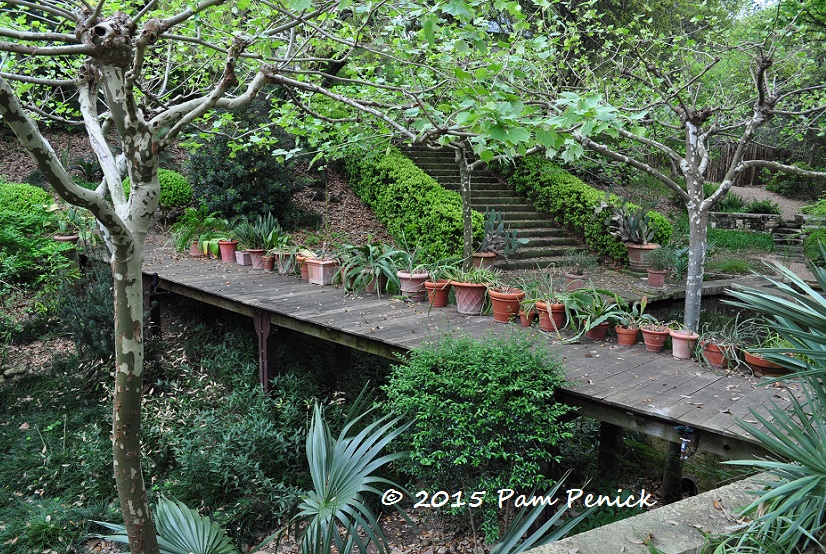
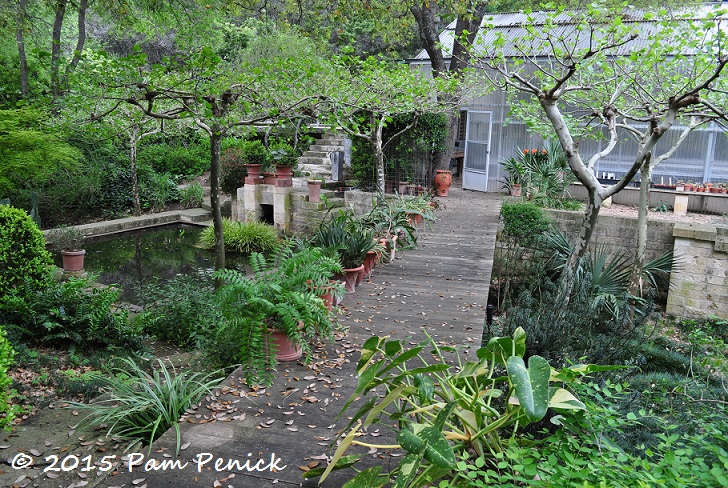
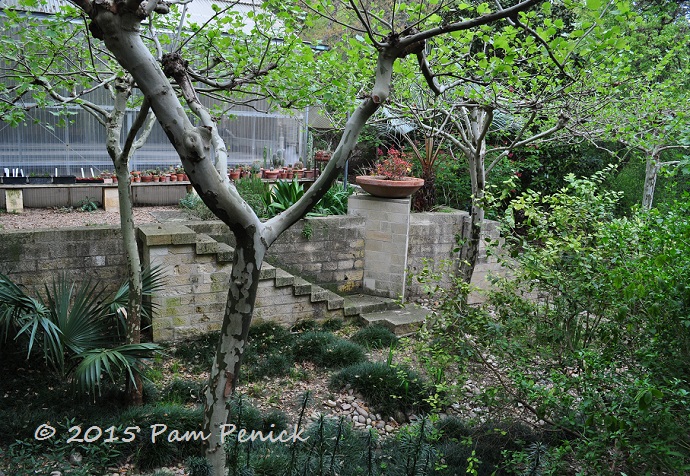
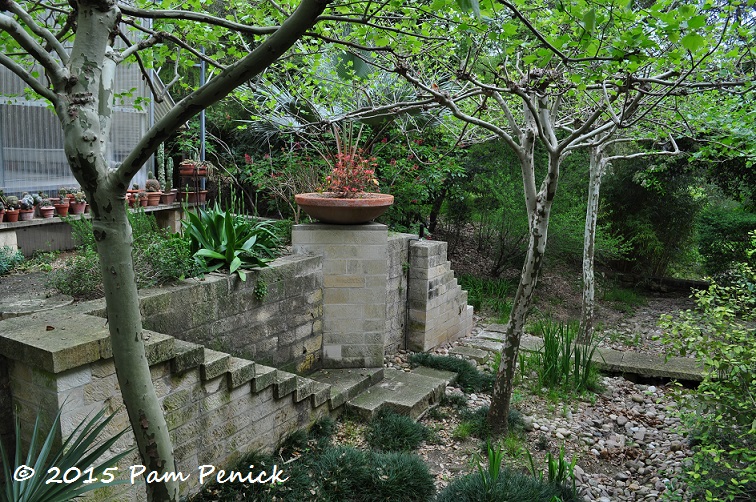
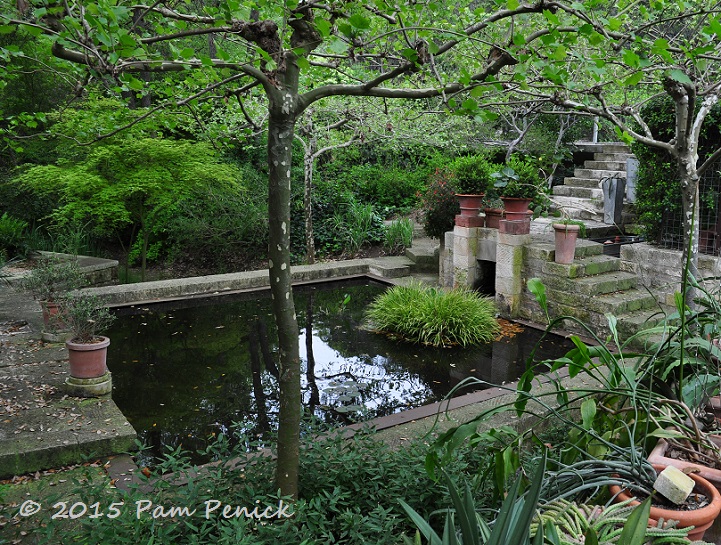
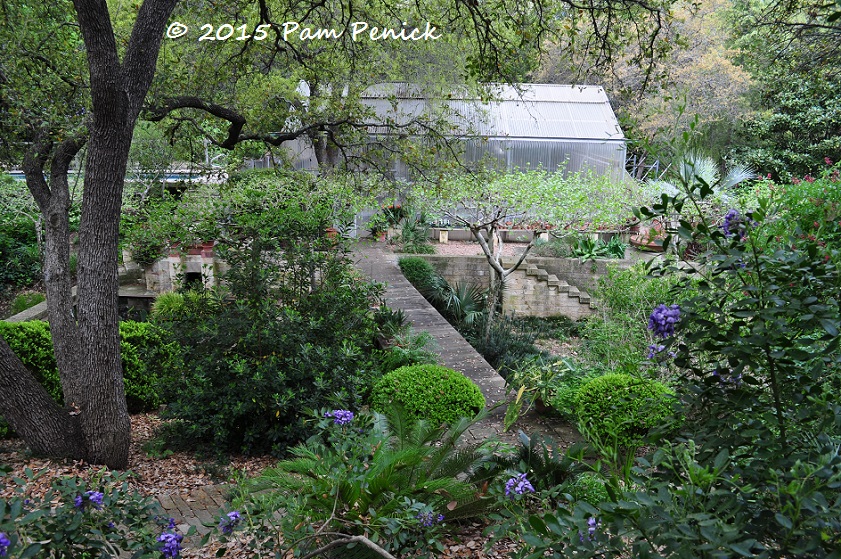
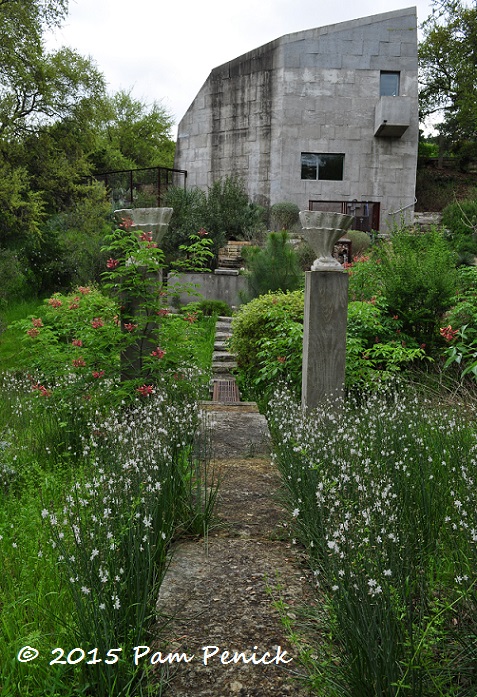
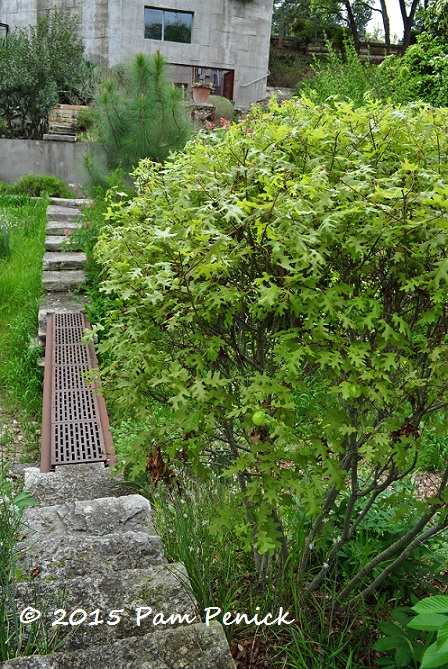
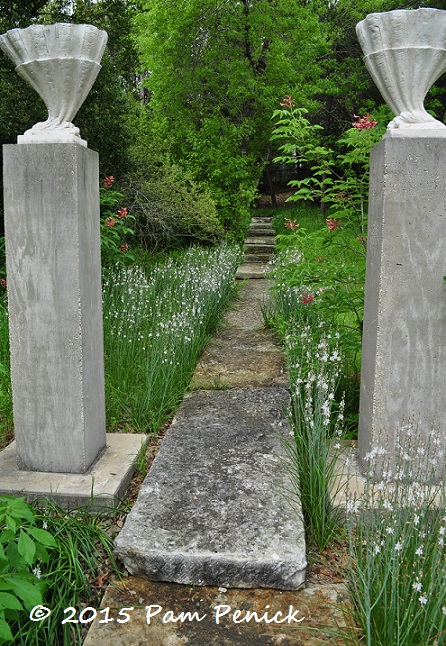
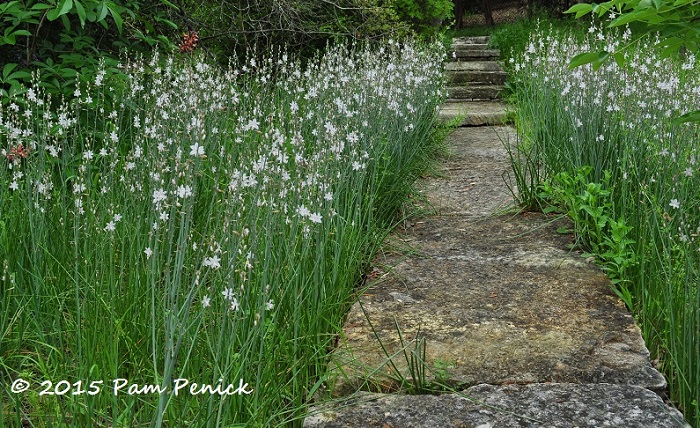
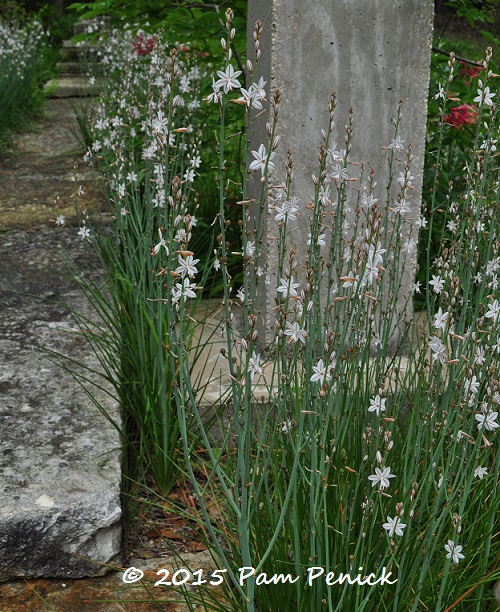
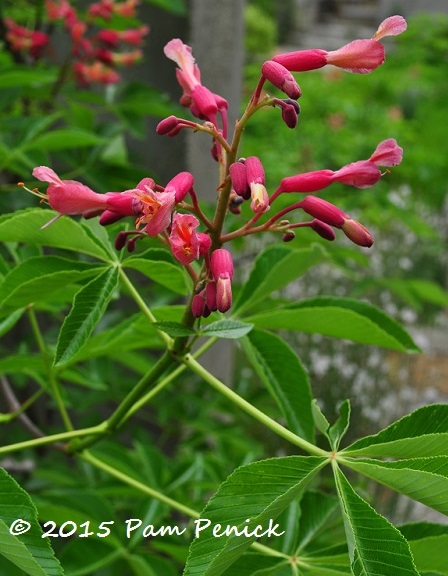
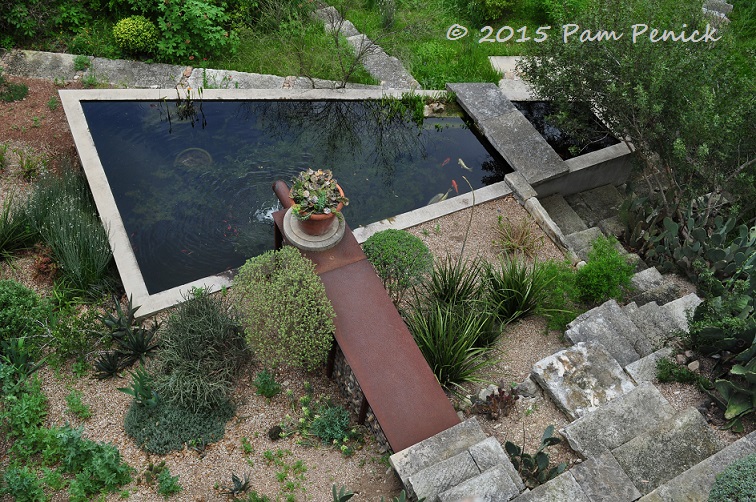
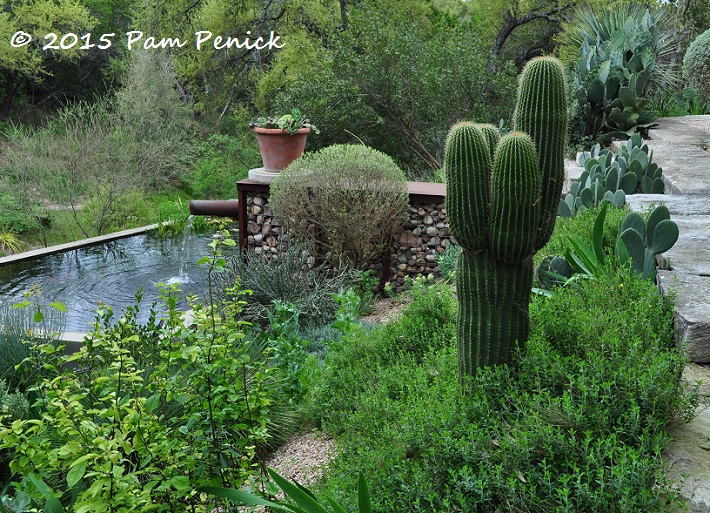
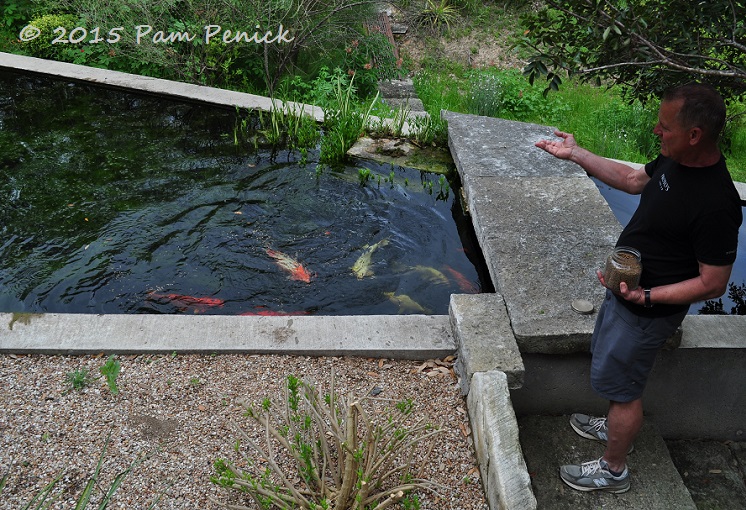
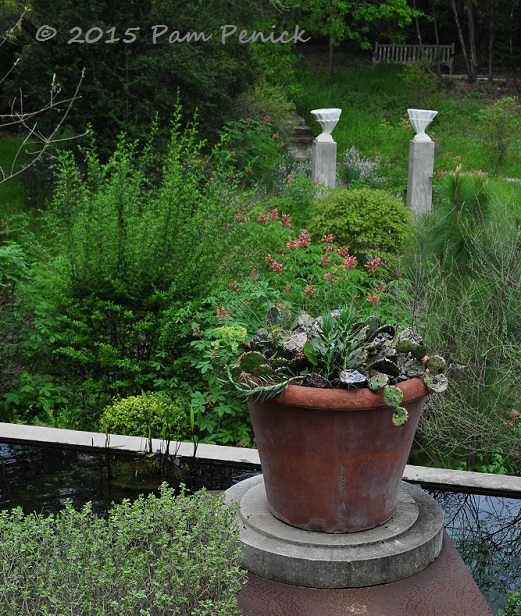
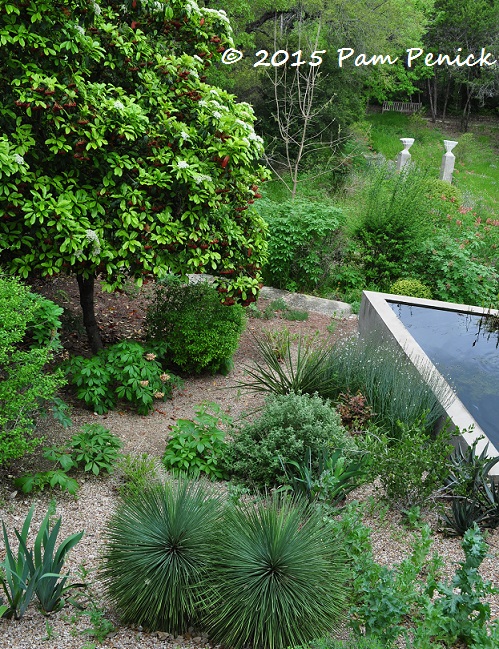
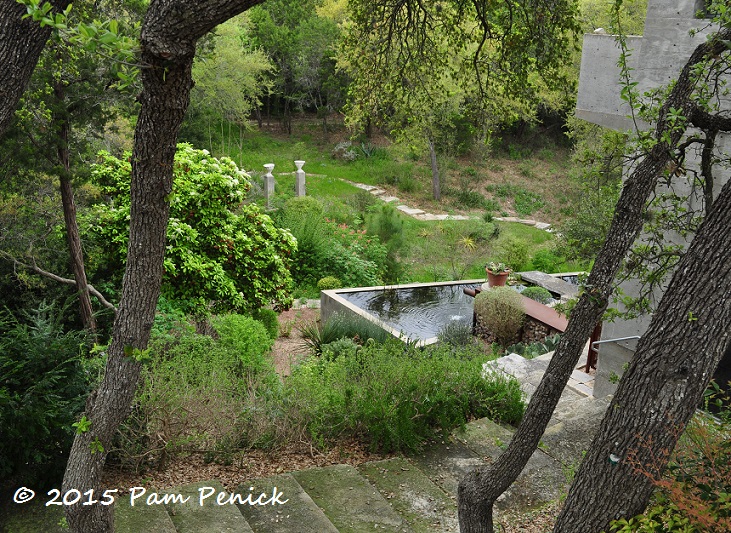
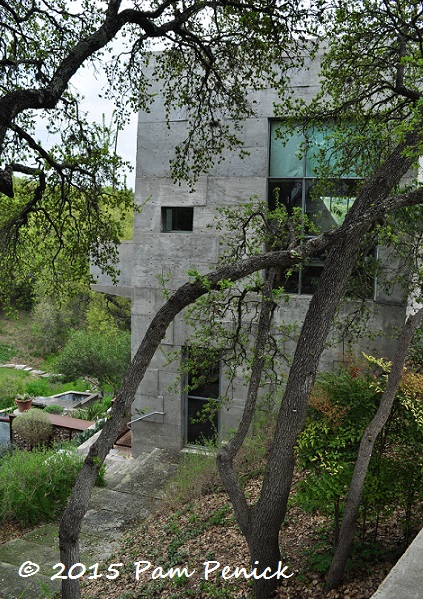
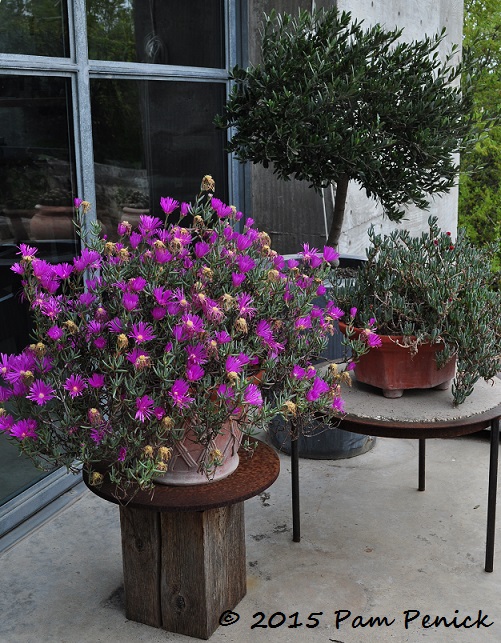
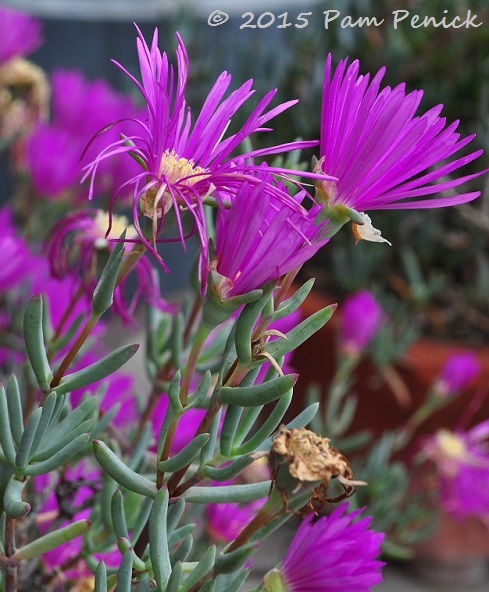
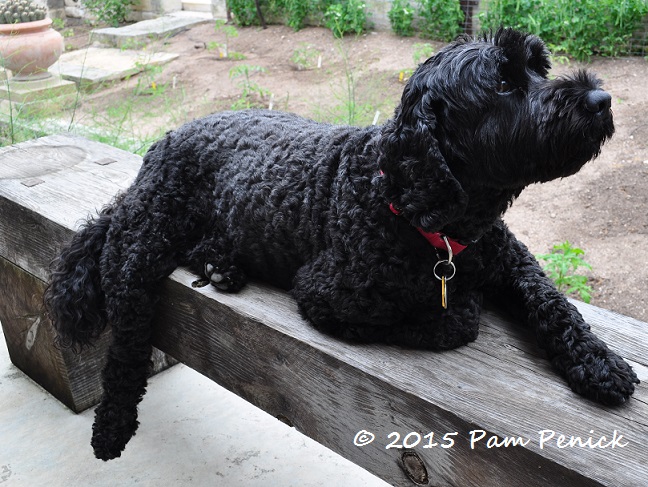

I remember the first time I visited this garden, so many years ago, and loved every inch of it. So many more inches have been added since then. Each time new places to explore and I see they haven’t stopped. Must be sad to leave but new adventures are always fun. I hope they find a like-minded buyer.
New adventures are fun, and they seemed excited about the move. I’m sure they would like to leave, though, knowing this garden is in good hands. —Pam
I wish you could follow them to their next garden and give a tour with regular updates at to the construction of their next masterpiece. This is just other worldly grand.
I am sure we’ll all be reading about their next garden one day. —Pam
So beautiful! So many ideas. I am more determined than ever to add a fountain to my garden. I have some of the tall, grassy white flowers out front. I don’t know the official name, but I remember it was called “Butterfly wings” or something like that. A google image search doesn’t find it, though.
You’re probably thinking of Guara lindheimeri, sometimes called Whirling Butterflies, and it does resemble that lovely plant. But that’s not it. I believe Diana, below, has correctly ID’d it. Thanks for commenting! —Pam
Oh ok. Thanks!
Thank you, Jenny. Hope you get your fountain! —Pam
Wonderful. The white blooming grass-like plants are St. Bernard lilies (Anthericum liliago). This is the part of the garden that I remember so well. I just love all that beautiful stone and hardscaping. Thanks for sharing.
Thanks for the ID, Diana! Are you growing this plant too? —Pam
Update: Although they do resemble St. Bernard lilies, the correct plant ID, I’ve just learned, is Asphodelus fistulosus. If anyone’s interested in knowing more about this controversial plant, read Laurie D.’s comment and James David’s reply, below. —Pam
I’m with Jenny. I hope they find a like-minded buyer, too. It’s so unique and creative. And inspiring! Thank you for sharing your gorgeous photos, Pam.
It’s my pleasure, Barbara. —Pam
Wonderful tour of a beautiful garden. Even though the scale is quite large, many of the design ideas here can apply to smaller gardens. Like others have commented, I do hope the new owners will open the garden again.
As you say, good design ideas can be translated to any size garden. —Pam
Thanks for this trip to paradise.
I’m glad you enjoyed it, Ricki. —Pam
Thanks so much for the farewell tour, Pam! Nice to see James’s garden one last time through your eyes.
I thought of you as being one of the talented designers around the country who got their start at Gardens, Rebecca. I’m glad you enjoyed the virtual visit. —Pam
I love their garden and loved seeing the changes from when I saw it in 2008 at Austin Fling. I can only imagine what their new garden will look like and I do hope that someone will share it with us.
Me too, Gail! —Pam
Pam, gardens are hard to take in with photographs, it’s never the same as being there. That said, you did a wonderful job moving in and backing away to show context. I really enjoyed the tour.
Thanks, Jeanne! —Pam
Wonder if they’d let a herd of us descend on them in their new garden?
Maybe in time, Vicki. They have always been generous with this one. —Pam
The lower garden reminds me of that wonderful and mysterious garden in Mexico, Las Pozas, created by an eccentric Englishman.
Some of it looks like glorious ruins; love their use of rocks and other hardscape material.
I don’t know that Mexican garden, Paula, but now I’m intrigued. —Pam
That has to be one of the most amazing private gardens I’ve seen! It needs to be public and kept in perpetuity.
Who knows, maybe one day. —Pam
These two posts about this garden have been spectacular! These gentlemen have created a masterpiece of a space and it must be difficult for them to leave it. Sure the new place is exciting and will also be wonderful but we pour our heart and souls into our gardens and part of ourselves is left with each garden we’ve created. Hopefully their property will be sold to someone who loves it as much as James and Gary do.
I wonder if the eventual buyer will buy it for the house or the garden? I’m glad you enjoyed the tour, Peter. —Pam
it was so nice to visit with you again as you went through the garden. I remember that so well from the very first garden bloggers fling. Thank you for taking us there again. I hope someone buys it he will love it as much as they have.
I’m so glad we were able to share this garden on the Austin Fling. It’s an amazing place, and I’m glad you here to see it, Dee. —Pam
I’m recalling a bit of past criticism aimed at these gardens for their high water use requirements. It could be quite daunting to manage and potentially transition such lushly planted grounds as our water restrictions tighten, though several gardens you’ve highlighted here on your site are prime examples of how xeriscaping need not look sparse or minimalist.
For the right owners, taking this property into more xeric plantings while preserving the charm could prove the challenge of a lifetime. I certainly hope you’ll be invited back for future tours when new owners take the helm!
Deb, I’m glad you mentioned the water-use controversy that haunted this garden a few years ago, when the owners applied for a water-use variance to sustain the garden. It was denied by the City of Rollingwood. I asked James about water use when I visited, and he said that when they were turned down for extra water in 2011 — the worst drought year in recent memory — he decided to go “cold turkey” on the extra watering and just see what pulled through. Some plants died, but he told me he was surprised by how much of the garden survived and even thrived despite the reduced watering. Currently he says he waters everything once a week, except for what I called the meadow garden and the dry garden by the studio, which are rarely watered. —Pam
That’s really interesting. My theory is many people habitually over water plants here in Central Texas. I think once a certain mass of plantings has been achieved, a micro-climate establishes that holds on to water more efficiently, stays slightly cooler, and needs nothing more than weekly watering (if that). I’m deeply happy to hear these beautiful gardens can be maintained without more than weekly watering.
I think this borders on “estate”. Your photos are so enticing, and I agree on the hardscape – planting combos. This is what I think of when I think Austin and garden, at least pre-hipster. Nicely captures its many moods…that’s it!
Pre-hipster — ha, yes, definitely. This is much more classic than hipster, although it does have a contemporary edge. —Pam
I had the pleasure of being awed by this garden many years ago.. Your photos do a great job in conveying its beauty.. As much as I dislike to be a bearer of bad news, I would like to submit a correction to the plant identified as St. Bernard’s lily. It is unfortunately, asphodelus fistulosus-commonly called onionweed. The telltale sign is the brown stripe down the center of each small petal. It is classified a federal noxious weed. It does look like bulbine and the two are related. That was one of my clues when I went on a long search to identify the madly multiplying plant when it showed up in one of my own gardens. If the property has been sold, I hope you may have a way to notify the new owners.
http://texasinvasives.org/plant_database/detail.php?symbol=ASFI2
Right you are, Laurie. Thanks for providing the correct ID for this plant, and for pointing out that it’s on the invasives list for Texas. I wrote to James to ask him about it, and this is his reply: “It is asphodel. It does seed freely but [is] easy to pull up, and it disappears once heat sets in by July. It reappears in November, blooming in late spring. In a small garden it could be a problem, but for me it is a treat.” —Pam
Heh, love it. Thanks for forwarding his response. I have a few wayward diehards that resist culling ;). A proud invasive, for sure. As James noted, they will grow through winter. In the 2 places I’ve seen them, they will bloom in late winter–before the bluebonnets. Given room, a single plant can be quite showy with offshoots and prolific blooms. In spite of their invasive status, I have only seen them in my garden and this one. And I do visit lots-public, private, rangeland….